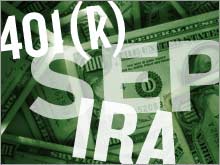|
Retire rich: Keep out the taxman
The right plan can help business owners protect their cash from the IRS.
(FORTUNE Small Business) - For five years, Richard Greene didn't give much thought to saving for retirement. He was more concerned with getting his new business off the ground. (Greene's 20-employee Liquid Technology in Hampton Bays, N.Y., buys and sells the tech gear that such clients as Nasdaq (Research) and Panasonic leave behind when they move or upgrade their infrastructure.) Sure, Greene socked away the maximum $3,000 or $4,000 in his personal IRA every year. But this year, after his 40th birthday, he asked his accountant about more aggressive retirement plans.
More wealthbuilders: 50 small-cap stock picks Greene learned that while his business once might have hindered his ability to save, it now allows him to participate in several plans designed just for entrepreneurs. "I want to max out," Greene says. "It's a good way to pay myself some money tax-free." A wealthy retirement
Call it the last stage of wealth building: keeping retirement money out of the hands of tax collectors. Many small-business owners shy away from retirement plans for fear of prohibitive costs and burdensome administrative tasks. But lately, providers have made entrepreneur-focused plans more user-friendly, with web-based tools to help clients pick the right one and in some cases set it up online. Some companies, such as Schwab (Research), have recently done away with most account service fees. And plan adoption appears to be spiking: Fidelity reports 25% year-over-year growth of small-business retirement plans in the past two years. Greene's accountant recommended a savings-incentive match plan for employees, better known as a Simple IRA. In this plan, participants - employer and employees - can contribute as much as $10,000 a year to a tax-deferred savings account. (Participants age 50 and older can add an extra $2,500 in "catch up" savings.) Plan options
Simple IRAs also require employers to contribute to their workers' savings: either 2% of salary for all employees or as much as 3% only for those who participate in the plan. This latter option makes Simple plans ideal for entrepreneurs who don't expect a high percentage of their staff to participate. Entrepreneurs with fewer employees may benefit from a simplified employee pension, or SEP, plan. With an SEP, a company can contribute as much as 20% of a self-employed business owner's annual compensation, up to $44,000. But it must make the same contribution for every employee, whether or not he invests his own money in the plan. (Workers with fewer than three years of service may be excluded.) "If you have 20 employees and you're giving yourself 5%, you have to give 5% to all of them," explains Fidelity's Tom McGirr. "It will quickly become cost prohibitive." As with the Simple, contributions to an SEP are considered tax-deductible business expenses, and earnings grow tax-deferred. Toni Rey thought she would never want to retire. A psychotherapist with a private practice in River Woods, Ill., she is the author of the 2004 book Still Working After All These Years: Why Retire? Working Into Your Sixties and Beyond. That attitude - and the hardscrabble financial life of a business owner - prevented her from building up much of a nest egg. So last year, at age 71, she opened an individual 401(k) - also called a self-employed or "solo" 401(k) - that lets her save as much as $49,000 a year. "My financial situation was such that I could not afford to put away that much until the past couple of years. Now I need to shelter as much money as I can," she says. Only sole proprietors, multiple owners, and spouses - with no other employees - can open an individual 401(k), but the plan boasts many of the benefits of a traditional 401(k) without the expense. Participants can accumulate savings quickly by making a salary deferral in addition to annual contributions. And those contributions are discretionary, meaning that business owners who face a lean year are not required to invest the same amount of salary. In 2006, individual 401(k) participants can contribute up to 20% of their self-employment incomes as well as a pretax contribution of up to $15,000. Those 50 and over can put away an additional $5,000. (Financial planners are starting to buzz over a new Roth alternative to 401(k) plans. It came into effect in January and allows high-income earners to put away some after-tax money in addition to their pretax contribution. Newly available with traditional 401(k) plans, it is not yet widely available with self-employed 401(k)s.) Entrepreneurs who don't fear administrative complexity have more options, although they may require the help of a tax planner or accountant. Business owners age 50 and older should consider defined-benefit plans. Participants must earn a salary of $225,000 and commit to contributing $60,000 a year for at least five years. Some types of defined-benefit plans, such as 412(i) plans, allow larger contributions but have complicated requirements. Not that all retirement savings need take the form of an IRA or a 401(k) plan. Consider, for instance, long-term-care insurance, which provides an unprecedented double saving. First, the premiums are deductible as a business expense, providing shelter for income. But the money can be withdrawn tax-free as well, as long as it is spent on costs associated with nursing-home care, assisted living, or home health care. Best of all, business owners are not required to provide the benefit for all employees - they can opt to cover only themselves and their spouses. More wealthbuilders:
_____________________________ The yin and yang of saving for retirement: 401(k) vs. Roth IRA. Click here.
Inflation proof your investment portfolio - in five easy steps. Click here. |
|


